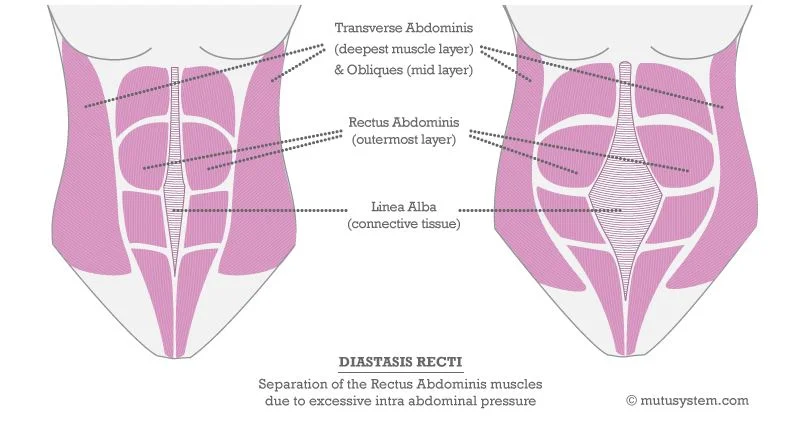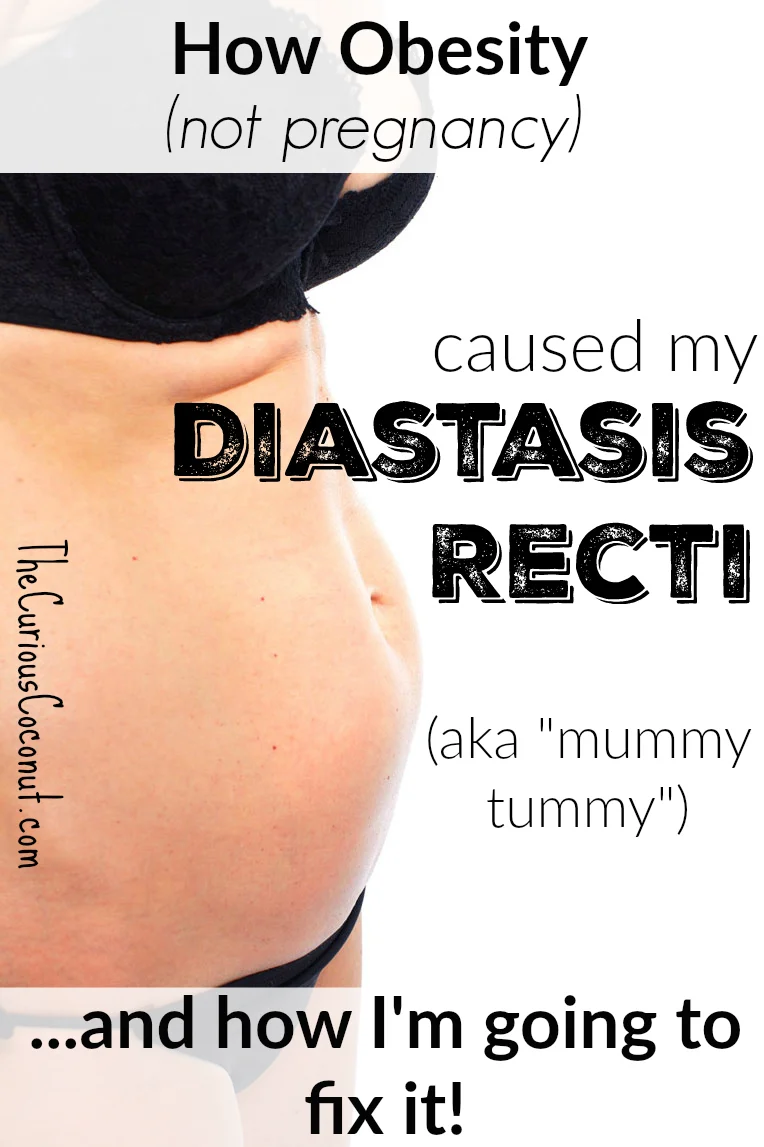A "diastasis recti" is an abnormal separation between the muscles that run along the midline of your abdomen. Diastasis means separation, and recti refers to the rectus abdominis muslces.
A diastasis recti is typically a problem most women face after pregnancy, due to the pressure exerted on the abdominal wall from within due to the growing baby. However, men as well as women who have never been pregnant can also get a diastasis recti. In my case, obesity caused my diastasis recti and other core muscle and pelvic floor dysfunction. This is difficult for me to share publicly like this, because my core dysfunction has been a source of embarrassment and shame for me despite my successes losing weight and regaining health these last 6 years.
At my heaviest in 2010, I was 210 pounds on my 5'5" frame. I carried a LOT of weight in my belly as visceral fat. Meaning, the fat was underneath the abdominal wall and surrounding my viscera, my organs. Visceral fat is considered one of the most dangerous types and is linked to a number of health problems, including metabolic syndrome, insulin resistance and diabetes, heart disease, and even cancer (especially in the colon, esophagus, and pancreas). This is totally a gross way to think about it, but, having a large volume of visceral fat in the abdomen is like being pregnant....with fat. Ew :-(
Thankfully, going Paleo helped me shed all of that excess weight rather effortlessly. I lost 80 lbs in the first year. So, by the Fall of 2011 I had lost the fat, but my poor belly was a wreck. I've known I had a diastasis recti and core muscle dysfunction for several years, but I am only just now getting around to doing anything about it.
Losing all of that weight really increased my confidence and self-image, but I have continued to feel shame over my belly. And lack of core strength is linked to having emotional issues, which I can certainly tell you is true from my own experience. I am so ready to finish the healing I started nearly 6 years ago and get to a place where I can feel happy and confident about my belly!
Anatomy of a diastasis recti
Let's take a look at what normal abdominal muscles look like, and what happens when there is a diastasis recti.
The rectus abdominis muscles are the ones that show up as a six pack. They are connected along your midline with a band of connective tissue called the linea alba. Separation can occur at any point along the length of your midline, between your sternum and pubic bone.
There is an easy way to check whether you have a DR or not by laying on your back, lifting your head (NOT shoulders) off the ground, and pressing your fingers into the center of your belly between your sternum and pubic bone. DR is measured in finger widths. See a demo of that here: how to check for a diastasis recti.
In my case, my DR is 3 fingers wide and runs from just below my sternum down to my belly button. Some women or men may only have a DR at and below the belly button instead, or it may run the full length, and be different widths at different positions.
Which exercises are good for a diastasis recti?
There is a lot of bad advice out there for postpartum moms and others who are looking to increase their core strength. Many of the commonly recommended exercises such as crunches and planks can actually do more harm than good. The reason is that in someone who is not properly engaging and connected with their abdominal muscles, these exercises can cause a large increase in intra-abdominal pressure, which further weakens the connective tissue between the muscles. Read more about that here.
The truth is that to fix a diastasis recti and regain a functioning core and pelvic floor you must do more than simply exercise. You must change your posture and change the way you move throughout the day, so that you get back in the habit of engaging your core muscles the way they are meant to be engaged with normal daily movement. That's where the MuTu System comes into play for me - it's a 12-week guided course that teaches you exactly how to reconnect with the muscles in your belly and pelvic floor. It is going to train me how to fix my posture, fix my movements, and how to do targeted exercises so I can learn to re-engage critical core muscles during normal movements.
What are side effects and symptoms of a diastasis recti?
Having a diastasis recti and core and pelvic floor dysfunction can cause your belly to bulge outward, especially after eating. In severe cases, the belly button can actually switch from being an innie to an outie, and the abdominal organs can even begin to herniate (poke through) the connective tissue right at the midline. Pelvic organ prolapse can also happen in severe cases. Incontinence when sneezing or exercising is another BIG red flag that you need to reconnect with your core - and, embarrassingly, this has just started to happen with me. I realized it when I was jumping on a trampoline a few months ago and was devastated, and knew I had to address things once and for all. Gastrointestinal problems such as bloating or constipation can also be a sign, since the muscles aren't supporting the organs the way they are supposed to. Finally, low back or sacroiliac join pain is a big signal that your core is not working properly.
Let's recap:
- low back pain
- pain in the sacroiliac joint
- pelvic organ prolapse
- herniation of the abdominal organs through the midline
- discomfort or pain when lifting objects, rolling over, sitting up, etc.
- gastrointestinal problems such as bloating or constipation
- incontinence, especially when sneezing, coughing, running, jumping, or exercising
MuTu System for diastasis recti & core and pelvic floor rehabilitation
I am so happy to be embarking on a 12-week journey with the MuTu System to address my issues. This is week 1 for me, and I've worked through all the preliminary science-focused info and introduction to the simple exercises of week 1. I have to say I just ADORE Wendy and her British accent. It's a pleasure to listen to her speak.
I am also so in love with the encouraging, non-judgemental, caring, gentle, loving approach of this system, too. MuTu is most definitely geared towards postpartum moms - hence the name. MuTu = Mummy Tummy. But, I can still take Wendy's message to heart, even though I'm not a mom. Being kind and loving to yourself is important no matter what circumstances brought you to the place you are at now. I went through hell and back with my health, and the physical impact of being obese was significant for me. It left my belly broken, too.
I've learned that I need to surround myself with messages of love, self-acceptance, and self-care. Some people may thrive by treating workouts as punishment with a "no pain, no gain" attitude, but that's certainly not for me. I tried that a few years ago with the Convict Conditioning program and it did more harm than good (and likely made my diastasis recti WORSE).
Have you had a baby? Have you been obese with visceral fat? Did you check yourself today and discover you've got a diastasis recti? Tell me in the comments!
Want to join me? There are 2 versions of the course: one that features more intense exercises to help you lose fat in addition to healing your core, and one that just focuses on rehabilitating your core. If you aren't sure which system you'd like to try, use this tool to help you decide. I am doing the full version.
July 2017 update:
My diastasis recti has closed to just ONE FINGER WIDTH!!!! And to offer some encouragement.....I was not very diligent with advancing through the exercises. In fact...I spent months repeating week 1 exercises while taking the week 2 alignment teachings to heart and using them in my daily life. I took my sweet time working through everything.
I've also adapted my yoga practice to keep my abdomen safe. I do still have some work to do on my pelvic floor but I think I know the reason why I've struggled: I was diagnosed with uterine fibroids at the end of 2016 (read about how I am healing them with Chinese medicine here). I expect that as they continue to shrink my pelvic floor strength will continue to improve.
Disclosure: Because I am so enthusiastic about the MuTu System (and about helping women to feel better about themselves), I decided to sign up to be an affiliate and help promote this awesome program. I also received complimentary access to the full 12 week course, and I will be sharing my honest opinion about the course as I work through it both here on the blog and on social media.
















After a long journey with uterine fibroids I have decided to have robotic laparoscopic surgery in early 2020 to remove them. To holistically prepare for surgery I am addressing food, exercise, sleep, stress, and supplements.